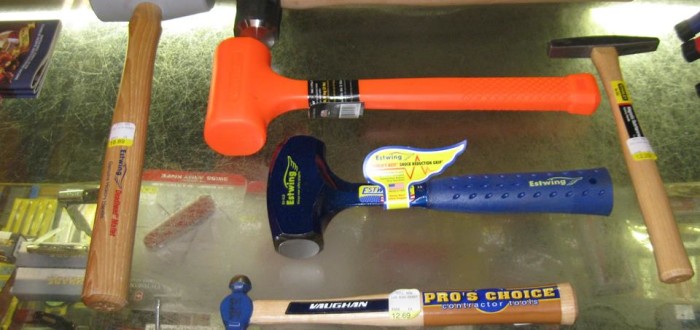Last time, we covered carpenter’s or nail hammers. Today I thought we would talk about other striking tools. Like I said last week, striking tools have a heavy head attached to a long handle to give leverage and are used to deliver a blow to another tool or object. If nail hammers are for hitting nails, what are other types of hammer used for?
One common type of hammer is the ball pein. The pein is the end of the head opposite the striking face, hence a ball pein hammer has a smooth flat striking face on one side and a hemispherical face on the other. Ball pein hammers are used in metal working to strike other tools like cold chisels. The pein side is used to strike metal directly and can be used to flatten rivets or other similar uses. Ball pein hammers are sized by head weight like nail hammers and run from quite small, four ounce or less to a couple pounds.
Once you get larger than that you are usually talking about sledge hammers, Sledge hammers have an octagonal shaped striking face on one or both sides and a short or long handle depending on the size of the head. Hand sledges run from two pounds to four pounds and have a short handle to be swung with one hand. Hand sledges also can have a cross pein on the back face. As the name implies the back face has a linear shape that runs across from side to side. Cross peins are used in blacksmithing work to draw out metal shapes. Hand sledges can be used for heavier metal working or light yard work, such as driving stakes into the ground.
Full sized sledge hammers run from six pounds up to twelve (or more!), and have a long handle to be swung with two hands, although I can tell you that to swing anything larger you had better have had your Wheaties that morning. Large sledges are used to drive large stakes, break up rocks or drive wedges when splitting wood.
Other less common types of hammers include tack hammers, with long narrow heads (often magnetized) for driving carpet and upholstery tacks. Drilling hammers, short sledge-type hammers used for hand drilling stone. Soft face hammers with soft metal, plastic or rawhide faces to strike finished surfaces without damaging them. Dead blow hammers which also usually have soft faces, have a load of lead shot sealed inside the head and when swung, the shot delivers the blow without rebounding off the struck surface. Very soft face hammers (properly called mallets) are made with wood and rubber heads for very delicate surfaces. Black rubber mallets will mark light colored surfaces though, so white “non-marring” ones are also made.
That about covers the remainder of the striking tool family. Although often used interchangeably, selecting the correct hammer for the job at hand often yields surprisingly better results. So don’ t be afraid to come down to the old hardware store to choose your correct “tools of destruction”.

